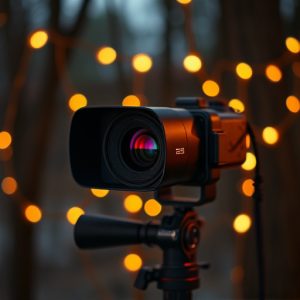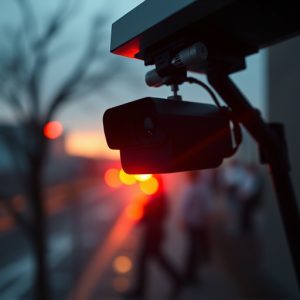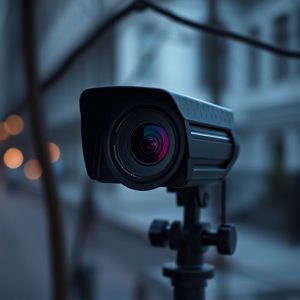Wireless Night Vision Cameras: Scanning Indoor Hidden Devices
Wireless Night Vision Security Cameras Indoors have revolutionized indoor surveillance by combining…….
Wireless Night Vision Security Cameras Indoors have revolutionized indoor surveillance by combining technology with design, offering clear night-time images via Wi-Fi or cellular networks. Their signal transmission methods include IR LEDs for lighting and data sending over wireless networks. Advanced scanning techniques detect these signals, helping to identify hidden cameras for comprehensive security. Non-invasive methods like infrared thermal imaging and RF signal scanning ensure discreet detection of covert listening devices in offices and homes. However, the ethical and legal implications of these technologies, particularly regarding privacy rights, are crucial considerations that users and manufacturers must navigate carefully.
Hidden recording devices pose a significant threat to privacy indoors. This article delves into innovative signal scanning methods employed by wireless night vision security cameras to detect these clandestine devices. We explore foundational concepts, including an understanding of wireless night vision technology and its evolving role in home and business security. Furthermore, we examine non-invasive techniques and advanced camera signal analysis tools. However, we also address the ethical considerations and legal implications surrounding these powerful surveillance methods.
- Understanding Wireless Night Vision Cameras: A Foundation for Signal Scanning
- Non-Invasive Scanning Techniques for Hidden Device Detection
- Advanced Technologies in Camera Signal Analysis
- Ethical Considerations and Legal Implications of Signal Scanning Methods
Understanding Wireless Night Vision Cameras: A Foundation for Signal Scanning
Wireless Night Vision Security Cameras Indoors have become increasingly sophisticated, offering a blend of advanced technology and discreet surveillance. These cameras leverage wireless connectivity and infrared (IR) lighting to capture clear images in complete darkness, making them ideal for indoor use where traditional wired cameras might not be feasible or aesthetically pleasing. Understanding how these cameras function is crucial for implementing effective signal scanning methods.
The foundation of this process lies in the camera’s ability to transmit video data wirelessly, often through Wi-Fi or cellular networks. IR LEDs illuminate the scene, providing the necessary light for image capture while remaining invisible to the human eye. Signal scanning involves detecting and analyzing these wireless transmissions to identify and locate hidden cameras. By understanding the unique signal patterns and frequency ranges associated with wireless night vision security cameras, professionals can employ specialized equipment to detect and scan for these signals, ensuring comprehensive indoor surveillance and data security.
Non-Invasive Scanning Techniques for Hidden Device Detection
Non-Invasive Scanning Techniques for Hidden Device Detection play a pivotal role in modern security strategies, especially when dealing with sensitive indoor environments like offices or homes. Unlike traditional methods that require physical access and disruption, these advanced techniques leverage cutting-edge technology such as Wireless Night Vision Security Cameras to remotely and discreetly detect hidden devices without causing any damage or interruption to the space.
One prominent approach involves infrared thermal imaging, which can uncover heat signatures of electronic devices not visible to the naked eye. This method is particularly effective for locating hidden cameras, tracking unauthorized devices, and ensuring data security in high-risk areas. Additionally, advanced signal scanning tools that analyze radio frequency (RF) emissions can detect anomalies indicative of covert listening devices or tracking software, further enhancing the ability to identify and mitigate hidden threats using Wireless Night Vision Security Cameras indoors.
Advanced Technologies in Camera Signal Analysis
Advanced technologies in camera signal analysis have significantly enhanced the capabilities of hidden recording device detection. With the rise of wireless night vision security cameras indoors, traditional methods of scanning for visual cues and manual inspection are no longer sufficient. Today, sophisticated algorithms and machine learning models can analyze video feeds in real-time, identifying patterns and anomalies that might indicate the presence of a hidden camera.
These innovative approaches leverage deep learning to detect subtle variations in pixel intensity, color distribution, and motion patterns, which often point to clandestine surveillance equipment. By continuously monitoring and cross-referencing data against known signatures, these advanced systems can proactively locate hidden recording devices within complex indoor environments, ensuring enhanced privacy and security for residential and commercial spaces alike.
Ethical Considerations and Legal Implications of Signal Scanning Methods
The ethical and legal aspects of signal scanning methods employed in hidden recording devices, particularly for indoor use with wireless night vision security cameras, are essential considerations. Privacy is a paramount concern; scanning and analyzing signals from electronic devices within private residences or commercial spaces can infringe upon individuals’ right to privacy. The collection and storage of such data must adhere to stringent legal frameworks, ensuring explicit consent from individuals whose activities are being monitored.
In many jurisdictions, laws protect the privacy of citizens, restricting the unauthorized use of surveillance technologies. Using wireless night vision security cameras indoors raises questions about the scope and limitations of signal scanning, especially when it comes to capturing and processing data without direct observation. It is crucial for manufacturers and users of such devices to stay informed about local regulations, ensuring their practices remain within legal boundaries and respect individual privacy rights.
Wireless Night Vision security cameras indoors have evolved beyond simple surveillance, integrating advanced signal scanning methods that detect hidden recording devices. From understanding camera fundamentals to exploring non-invasive scanning techniques and leveraging advanced analysis technologies, this journey highlights the importance of ethical considerations and legal implications. As we navigate these innovative solutions, it’s crucial to balance privacy concerns with effective security measures, ensuring a safe and technologically enhanced indoor environment.


